One thing most of us, me included, tend to overlook is that these days there are very, very few anglers actually fishing the rivers compared to, say, the 1980’s. Go back even further; can you remember rivers near towns where, if you did not get there early, you had to walk for what seemed like miles just to get a swim to fish?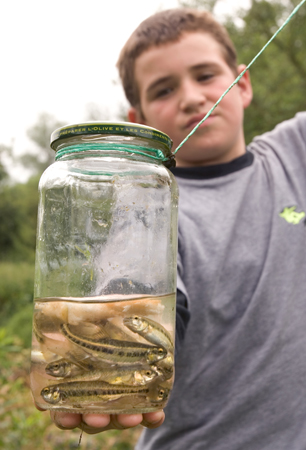
Whole families would go for a picnic by the river and while dad fished mum would set out a small blanket, settle down with a good book and read until it was time to spread out the food and call everyone to eat. The kids would rush around exploring, perhaps even fishing, with a short, shop bought metal or cane rod with a 2in Bakelite or wooden reel. Or perhaps they would just splash around with a net on a cane searching for some tiddlers and sticklebacks to display in a jam jar.
Toady was there; probably with a much-loved and cherished cane rod, the one with a greenheart top section. Or maybe it was that rather special rod lovingly constructed in split cane? The reel was generally a wooden one, although there were a few Bakelite models and very occasionally a metal one.
Wooden line winders were the norm with hook, weights and float already fixed in place. The additional yards of line, once unwound, would be tied to the main line with the knot ending up a good few turns on the reel. The biscuit tin tackle box held the lead weights, a plummet or two and a few leger weights, perhaps a spiral twist, a coffin lead or drilled bullets.
Completing the tackle requirements were paper packets with a few different sizes of loose hooks and maybe a few shop bought hooks already tied to line. A “V” shaped disgorger and maybe a few double or treble hooks and a selection of floats. Seating at best was a fold-up metal stool or perhaps a wooden one but often nothing except a piece of tarpaulin.
Remember back to the days where you would rarely ever see a man shopping. Oh no, he was off fishing or at the football while his dutiful wife did all the shopping; dad went out to work and most women were housewives. Even the women that worked were also expected to look after the house, clean, wash, iron, shop and cook as well as feed her family and husband. In the evenings he might go out to the club or pub while she was left to read, listen to the radio or perhaps watch television. Sure, they did other things, but perhaps one might guess that this was the base from which most ordinary families lived.
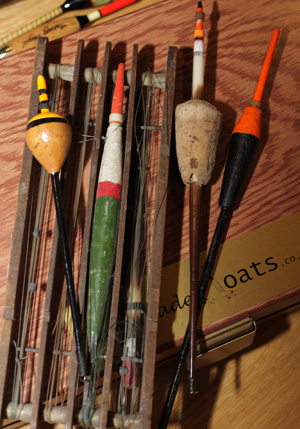 In those days, most fishing clubs were run from the back room of pubs or perhaps an upstairs room. Often, the anglers would simply take over a bar and sort out the club business while they downed a few pints. Of the clubs themselves you could generally say that all the members knew each other and every club would have a couple of members who made or repaired tackle. They were brilliant at whipping a new ring on a rod and would often do it while enjoying a pint.
In those days, most fishing clubs were run from the back room of pubs or perhaps an upstairs room. Often, the anglers would simply take over a bar and sort out the club business while they downed a few pints. Of the clubs themselves you could generally say that all the members knew each other and every club would have a couple of members who made or repaired tackle. They were brilliant at whipping a new ring on a rod and would often do it while enjoying a pint.
A club match was usually just that with most of the club members attending and competing. Then there were club outings with coaches packed with anglers and tackle, or perhaps the early train. In some towns there were very early morning departures known as the milk trains and it was on these that many an angler could be found laden down with rods and tackle bags. Sometimes the tackle included a special livebait tin, about 6in x 6in x 12in, made of metal with an oblong, hinged top with drilled holes and, of course, water sloshing about and a few fish struggling to survive within.
The uniform of the day was a jacket, always dull or darkly coloured to our modern eyes, a white shirt with the compulsory dark tie just visible in the ‘V’ neck of a cardigan or pullover, flannel trousers with turn-ups, leather boots all topped off with a trilby hat or, more likely, a flat cheese cutter cap.
So it’s not yet 4am, Toady is dressed and checking his tackle bag, satisfied he creeps up to kiss his wife goodbye and donning his jacket he stuffs the outside pockets with a flask of tea and a greaseproof bag with few sandwiches in. He’s off to meet some fellow anglers for a day’s fishing.
Getting to the station he greets a couple of friends and checks have they got his pint of maggots from the tackle shop. He slips the bait into his holdall and they cheerfully chat about the coming day as they wait for the 4:20am to the countryside…and the river.
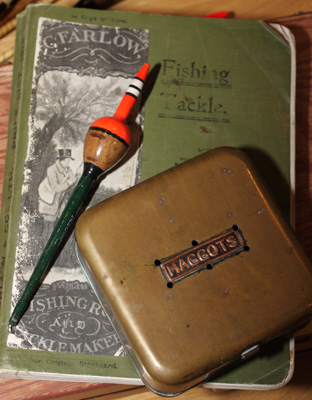 It’s just before dawn as the train pulls into the station on this early autumn day and the assembled group start the mile walk to the river. The stroll down the quiet, country lanes is punctuated with laughter, joking and good natured teasing of the youngsters – banter it’s called today.
It’s just before dawn as the train pulls into the station on this early autumn day and the assembled group start the mile walk to the river. The stroll down the quiet, country lanes is punctuated with laughter, joking and good natured teasing of the youngsters – banter it’s called today.
They arrive at the riverbank and with looks of disappointment realise they are late; Toady knew they should have got the earlier train! Never mind, it would just mean a longer walk and probably an earlier pack up if they were to catch the homeward bound train on time. Finally, they find some empty swims and decide they have walked far enough. They joked they should have left the train further up the line just to find a fishing spot.
Toady opens the twin handled ex-military canvas holdall wherein lies the secrets of an angler. He removes his aluminium maggot box and some bread in its paper bag, next comes his tackle tin. He puts up his stool and unfolds his keepnet which was tied to the outside of his rods. Taking care to keep hold of the fixing string he throws the keepnet into the water and attaches the string to a bankstick, next he takes up the handle of his landing net and attaches the net.
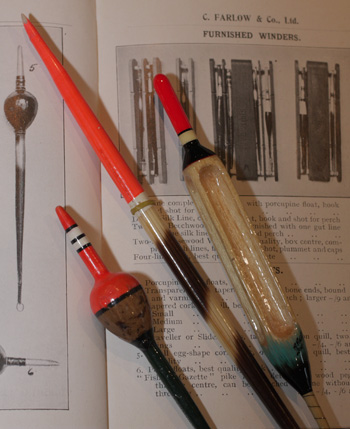 Finally, it’s time to set up the rod. Checking the alignment of the rings he pushes the brass ferrules home and slides up the reel rings to secure his reel. Undoing some of the line from the winder he threads it down the rod towards his reel. Then he sits down and expertly joins main line to leader. He finishes unwinding the business end from the winder and takes up the spare on the reel. Finally he hooks the hook onto the first ring of the now complete rod and takes the remaining slack up. The complete set up is now ready and is placed in the bank stick with its pre-attached rod rest.
Finally, it’s time to set up the rod. Checking the alignment of the rings he pushes the brass ferrules home and slides up the reel rings to secure his reel. Undoing some of the line from the winder he threads it down the rod towards his reel. Then he sits down and expertly joins main line to leader. He finishes unwinding the business end from the winder and takes up the spare on the reel. Finally he hooks the hook onto the first ring of the now complete rod and takes the remaining slack up. The complete set up is now ready and is placed in the bank stick with its pre-attached rod rest.
Taking out a small canvas bag Toady goes to the water’s edge, undoes the string securing the top, and then very carefully, dunks the bag into the water allowing a little of the water to flow over the top. Satisfied he lifts the bag and begins to mix the contents. Again he dunks the bag letting a little more water flow into the bag, more mixing ensues and he smiles. Returning to his stool he removes half a handful of the contents of the bag and adds a few maggots. Rolling it up into a ball he tosses it upstream into the river. Wiping his hands on a cloth he picks up his rod, puts a maggot on the hook and underarm casts out into the stream.
Toady visibly relaxes yet is attentive as he watches the quill settle down into the water. He has often fished here and knows the water well enough not to bother with plumbing the depth. Yet, looking with modern eyes, his float does seem to be showing rather a lot of tip. But wait he is not happy at the progress of his float; he reels in and adjusts the depth by a few inches. Putting a new maggot on he again casts underarm and slightly upstream of the area he threw the groundbait.
Now watching the float with a concentration that is seldom seen outside of angling circles he constantly dresses the line, reeling in as the float gets level with him, then turning the rod so the reel is moved from the vertical to a horizontal position. Perfect technique to allow the pace of the water take line as the float makes it way downstream.
Suddenly the float dives like a submarine and Toady strikes; feeling that assured thump as the hook is driven home into the lip of what feels like a very decent chub of perhaps a couple of pounds. Not a bad start to what looks a promising day; Toady slips the chub into his keepnet.
Toady re-baits and casts out again throwing a few loose maggots in as soon as the float hits the water. The pattern is only broken when he sits back and pours a cup of tea from his flask. He smiles, glancing at the waters reflection of the trees gently blowing in the soft early autumn breeze; hardly a leaf has begun to change into its bright autumn shades.
Suddenly his hand grabs the rod and Toady strikes. Holding the rod high he puts his cup down, begins batting the reel with his left hand but realises this is a much better chub. The rod arches as the wily fish makes a dash for the protection of some overhanging tree roots. The fight is on, first the fish taking line and bending the rod further, then Toady just managing to ease its head up. So the struggle continues until at last the chub breaks the surface. Toady knows now is the most dangerous moment, clasping the reel and rod with one hand he eases the landing net into the water steadily guiding it to the net. Safely netted Toady carefully removes the barbed hook with the disgorger and pops the fish into the keepnet.
Ha, those were indeed the times, days of Mr Crabtee indeed, but wait a moment…time has moved on and it is so very different for the river angler now…
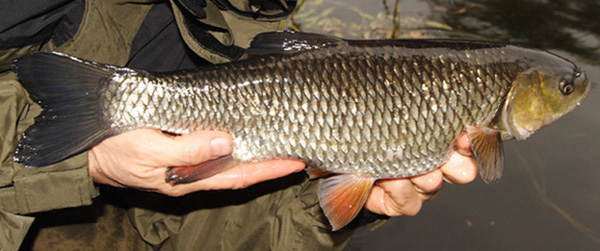
His tackle is ever ready; the bait he bought days ago was stored in the fridge. Quickly loading the tackle into the car he slips back into the house to pocket his mobile phone before soundlessly leaving without a backward glance. A thirty or so minute drive and he is parked close to the river.
Unpacking the tackle onto a lightweight trolley with pneumatic tyres, adding a lightweight, comfortable, high-backed chair followed by a compact, waterproof tackle bag. A pair of matched reels with spare spools sits in an outside pocket. The main compartment holds a large box which, in itself, contains two matching boxes. One holds everything the modern angler must have in neatly divided sections whilst the other, configured entirely differently, contains rows of floats all neatly lined up in sizes, shapes and colours.
Matching bait boxes, flask and perhaps a sandwich in another outside pocket complete the ensemble. The landing net fits snugly between bag and chair. The lightweight day shelter is added to the rod holdall/quiver which safely holds telescopic landing net handle and a couple of lightweight carbon rods. Aerolastics secure everything firmly in place and the modern, compact, lightweight angler is off on a short jaunt to the water’s edge.
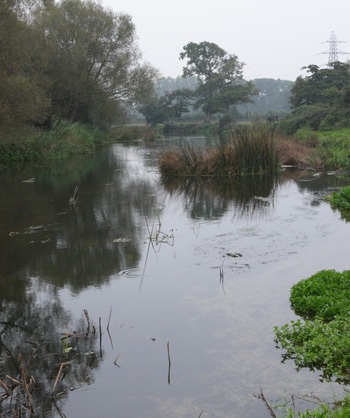 Looking up and down the bank Toady wonders where looks a good place to fish? Nobody is around today, not that there ever is, the bank is totally deserted and he can choose any swim he fancies. You know it will be one that looks the most promising for producing some good fish on this early autumn day although the flow appears to be a little slow. Not much can be seen moving, there are three ducks, a pair of swans and the light early autumn breeze is making the reeds sway gently and the cabbage is still standing high and strong.
Looking up and down the bank Toady wonders where looks a good place to fish? Nobody is around today, not that there ever is, the bank is totally deserted and he can choose any swim he fancies. You know it will be one that looks the most promising for producing some good fish on this early autumn day although the flow appears to be a little slow. Not much can be seen moving, there are three ducks, a pair of swans and the light early autumn breeze is making the reeds sway gently and the cabbage is still standing high and strong.
Toady decides to stop where he is and undoes the aerolastics and sets up his chair then, considering that it might get a bit windy later, reaches for the day shelter. Assembled and pegged out in moments he positions the chair inside. The landing net is assembled, extending the handle to its full extent and balancing it on the reed bed.
From the tackle bag he retrieves a large rod rest, attaches it to a bankstick and pushes it into the same reed bed. Now comes the rod; a lightweight, stiff carbon product fourteen feet long to which is attached one of the fixed spool reels. Again looking up and down the empty river he chooses a spool loaded with two pound line, smiling as he considers the possibility of a good chub but he secretly hopes the chub are all asleep.
The line is quickly threaded through the high rise rod rings and he again reaches into his tackle bag. A fine needle tipped canal dart looks suitable and is held in position solely by its bottom loop. Again Toady reaches into the tackle box to pick up a wallet of hooks already tied to monofilament by the manufacturer, smiling as he thinks ‘now why did I pick this up when I have my own home tied hooks?’ He ties a loop in his main line and threads the hook length on securing it with the minimum of fuss. Settling on a size twenty barbless hook and immediately fixing a tiny size 12 micro shot to the line some four inches from the hook he grins and remembers how many others have laughed at his obsession with ultra lightweight tackle.
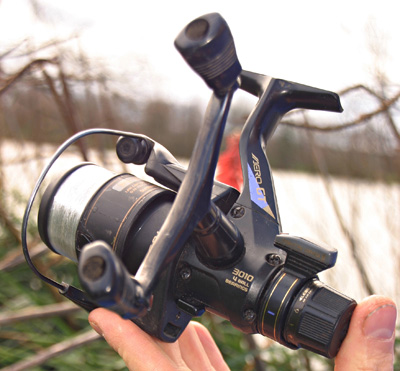 Toady never could understand their inability to play and land a good fish on light tackle. It’s so obvious and simple – just learn to feel what you are doing and what is happening underwater; do not get excited, anxious and bully the fish, relax take things easy, sure it may take a little while to land the fish but you have all day and your quarry deserves better in return for the pleasure it is giving you.
Toady never could understand their inability to play and land a good fish on light tackle. It’s so obvious and simple – just learn to feel what you are doing and what is happening underwater; do not get excited, anxious and bully the fish, relax take things easy, sure it may take a little while to land the fish but you have all day and your quarry deserves better in return for the pleasure it is giving you.
Placing the hook in the hook carrier on the rod Toady puts the rod in its rest with the butt on the seat of the chair. Picking up the folded bait mixing bowl he first pours a dry, powdery mix followed by some strange coloured liquid from a flask with big crosses painted on it. Realising it needs more liquid he dunks the cup from the flask into the river adding some of the water he then mixes the ingredients for his groundbait until satisfied it’s just right. He then starts to form small balls the size of ping pong balls. Once satisfied he has enough, he cups each one and makes a deep indentation into it; opening his box of hook bait he puts some in each ball and moulds it back into a round ball again.
Toady folds up his trolley and moves that and his rod bag to the side of the day shelter, the tackle bag goes under the shelter and sits next to the chair. Looking around to see nothing has been left out he sits down and just looks at the water flowing past.
Suddenly, and with no obvious trigger, he throws some of the balls of groundbait into the river then hurls another further downstream and another even further downstream and yet another, then two slightly nearer to the main bulk of groundbait. Picking up a catapult, he fires several times, each loading just a few samples of his hook bait in some pattern he has in his mind.
Leaning back, Toady takes out a wet wipe and cleans his hands thoroughly, then pours a cup of coffee from his other flask. Still he sits enjoying the scenery, rod lying untouched, hook not yet baited, seeming so relaxed one might think he will fall asleep.
Slowly enjoying his coffee, unmoving other than to lift the cup from lap to lip, his eyes half closed appearing to be on the edge of sleep, he hears a splash downstream. Still he remains unmoving bar finishing his coffee. A second splash of another moorhen even further downstream, he quietly replaces the cup on the flask. With the minimum of movement he picks up the rod and, unhooking the hook from its keeper, he baits up.
Yet still the movements are limited, Toady raises the rod and casts underarm quite a way upstream. Gently and unhurriedly he reels the line and float to the spot he has chosen for the first run. A final dressing of the line as the float passes under the rod tip and back goes the bail arm, the rod now resting partly on the rod rest and partly in his hand.
Suddenly and with a speed that would surprise a snake, he strikes, but at what? Any onlooker would confirm the float never went under; the rod arches as the strength of the hooked fish fights against its tethering. The clutch screams and he smiles knowing that he has his first good roach on the hook. Easily given away by the movement of the float, although that movement was less than an inch from the line the float should have taken.
Still totally relaxed and not attempting to reel in, Toady’s finger resting against the spool applying and easing pressure as he first moves the rod this way then that as he begins the task of tiring the fish. Without any obvious sign he reaches for the landing net and moves it so it is just in the water. Now, leaving the net balanced and held between leg and chair, he reaches for the reel with his left hand and begins to reel line in; a little at first but gently and steadily increasing as the fish relaxes in submission. Toady lowers the rod and reaches for the landing net softly pushing the net deeper into the water. Now he guides the fish to the net using the rod and his right hand alone, lifts the net surrounding the fish and smiles.
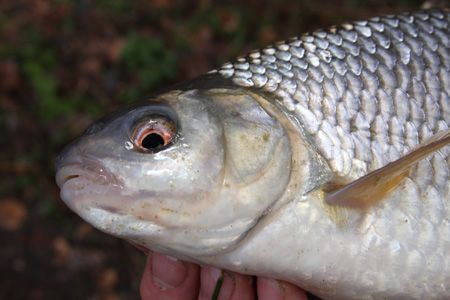
Putting the rod in the rest, he flicks the bail arm open and raises the landing net drawing it and its fishy cargo to his seated position. Toady deftly unhooks the two pound roach and smiles at the feeling of success and accomplishment of his first fish of the day.
With respect and courtesy, Toady moves onto his knees, takes the net and fish towards the water where smoothly and carefully he returns the fish to its river…










